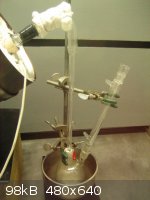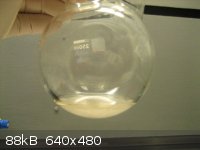| Pages:
1
2
3 |
garage chemist
chemical wizard
    
Posts: 1803
Registered: 16-8-2004
Location: Germany
Member Is Offline
Mood: No Mood
|
|
Yes, of course you can do that, chlorosulfonic acid is isolated by quick atmospheric distillation.
But I would recommend to make more SO3 first- pool a few batches, and convert them to ClSO3H together. It does not require more lab time to make 200g
chlorosulfonic acid than it does to make 20g.
|
|
|
Magpie
lab constructor
    
Posts: 5939
Registered: 1-11-2003
Location: USA
Member Is Offline
Mood: Chemistry: the subtle science.
|
|
Quote: Originally posted by Magpie  |
My charge of NaHSO4 was 100g. I'm estimating by eye that there may be about 10g of SO3 in the 250ml RBF receiver. I will be able to report this
accurately only at a later date as I neglected to tare the receiver.
|
I now have the weight of oleum from my 18-1-11 preparation from NaHSO4. I titrated 0.5mL with 1N NaOH to a phenolphthalein endpoint. This yielded a
value of 81% oleum. The total weight was 25.9g. The pool grade NaHSO4 was 95% strength so the yield was 78.9% of theory.
My quartz glassware is being modified to eliminate the lower joint. When complete I will be back in production of this useful reagent. 
The single most important condition for a successful synthesis is good mixing - Nicodem
|
|
|
Magpie
lab constructor
    
Posts: 5939
Registered: 1-11-2003
Location: USA
Member Is Offline
Mood: Chemistry: the subtle science.
|
|
My quartz glassware modification was finally completed so yesterday I made another SO3 run using NaHSO4 in my tube furnace. This time the quartz
tubing performed flawlessly and I had no leakage. Net weight of oleum is 29.2g based on a charge of 100g of 95% pool grade NaHSO4.
As you can see in the picture below the oleum is a mixture of liquid and solids. This presents a problem for assay and usage. I withdrew 0.5mL of
the liquid and titrated it. It is 50.5% oleum. But now I don't know the assay of the solids, and I don't know what % of the whole is solids. So I
can't determine a yield.
More importantly, for my intended usage, I need to prepare 20% and 66% oleum. I could melt the solids by heating to 36C, but I estimate the vapor
pressure would rise to 375mmHg (for 100% oleum) at that temperature. Anyone have any suggestions as to how to solve this problem?
 
[Edited on 17-3-2011 by Magpie]
The single most important condition for a successful synthesis is good mixing - Nicodem
|
|
|
garage chemist
chemical wizard
    
Posts: 1803
Registered: 16-8-2004
Location: Germany
Member Is Offline
Mood: No Mood
|
|
From oleum with a SO3 concentration between 20 and 65%, solid disulfuric acid H2S2O7 crystallizes out.
This problem is solved by distilling off the SO3 (H2S2O7 also loses its SO3 then) and adding the calculated amount of conc. H2SO4 to form the desired
oleum strength.
|
|
|
Magpie
lab constructor
    
Posts: 5939
Registered: 1-11-2003
Location: USA
Member Is Offline
Mood: Chemistry: the subtle science.
|
|
Thank you GC. I'll post the results.
The single most important condition for a successful synthesis is good mixing - Nicodem
|
|
|
Magpie
lab constructor
    
Posts: 5939
Registered: 1-11-2003
Location: USA
Member Is Offline
Mood: Chemistry: the subtle science.
|
|
I tried to distill my oleum today to obtain pure SO3 as distillate. I had to abort, however, as the amount of smoke coming out the tubulation on the
vacuum adapter was threatening to overcome the capability of my fume hood. I had the heat set low (45%) on the heating mantle and had not as yet seen
any distillate come over. Cooling water was cold tap water - no ice added.
The solids in the pot did melt so I took another 0.5mL sample for titration. The results indicated 13% oleum.
I feel that on future SO3 production runs with the furnace I should make sure that all water/H2SO4 has been withdrawn from the receiver before the SO3
starts coming over in earnest. I did this at T=660C using a pasteur pipet. Apparently that was not good enough.
Any other suggestions?
The single most important condition for a successful synthesis is good mixing - Nicodem
|
|
|
Rosco Bodine
Banned
Posts: 6370
Registered: 29-9-2004
Member Is Offline
Mood: analytical
|
|
Spin the vapor using a long graham condenser to see if that centrifuges and coalesces out the fine droplets you can maintain the condenser above the
m.p. of the SO3 so it doesn't plug.
|
|
|
Magpie
lab constructor
    
Posts: 5939
Registered: 1-11-2003
Location: USA
Member Is Offline
Mood: Chemistry: the subtle science.
|
|
Quote: Originally posted by Rosco Bodine  | | Spin the vapor using a long graham condenser to see if that centrifuges and coalesces out the fine droplets you can maintain the condenser above the
m.p. of the SO3 so it doesn't plug. |
Rosco that is an interesting thought. I do have a Graham condenser but it is short and doesn't have ground glass connections.
Some lessons learned
Up until now I have been assaying my oleum by titration. I now feel that this really is not reliable for two reasons: 1) determining the amount of
oleum added to the titration flask using a 1 mL pipet is not accurate due to the high viscosity of the oleum and the lack of accurate sp gr
information, and 2) the oleum fumes badly when placed in the titration flask containing water. Any slight variance in the volume delivered or the sp
gr used greatly affects the calculation of the assay.
So, today, taking a lesson from Len, I did an assay by evaporation of a weighed amount of oleum, ie, 1.58g. Firstly, I would like to say that it took
forever for the SO3 to completely evaporate and I had to heat the 25mL RBF to get it to proceed to completion. All during this evaporation copious
fumes of dense white smoke are coming off, at times challenging the fume hood. The result of this assay was 60.7% oelum. Much different than the 13%
I reported yesterday using the titration method.
Using 60.7% oleum, the yield of SO3 for the furnace run is 85.6% based on the NaHSO4 charged and 29.2g of product.
SO3 and oleum are most interesting and useful. Handling the oleum is tricky and dangerous, and I'm still learning. My efforts so far would not have
been possible without an efficient fume hood.
Edit:
Here's a short video showing my dilution of 0.5mL of the 60.7% oleum for titration:
http://www.youtube.com/watch?v=XJDohfwbffU
[Edited on 20-3-2011 by Magpie]
[Edited on 21-3-2011 by Magpie]
The single most important condition for a successful synthesis is good mixing - Nicodem
|
|
|
Rosco Bodine
Banned
Posts: 6370
Registered: 29-9-2004
Member Is Offline
Mood: analytical
|
|
An electrostatic precipitation chamber might do the job of marshaling SO3 vapor into a coalesced form. Something custom built for the purpose would
probably be required. Graphite might hold up for electrodes .....I'm not sure.
|
|
|
Jon_Swars
Harmless

Posts: 3
Registered: 18-5-2011
Member Is Offline
Mood: No Mood
|
|
@ rb THATS NOT RIGHT
You obviously havent a clue. Reading the board in general you appear to persist in
evacuating the contents of your bowels all over same.
Jon
|
|
|
hissingnoise
International Hazard
    
Posts: 3940
Registered: 26-12-2002
Member Is Offline
Mood: Pulverulescent!
|
|
| Quote: | Reading the board in general you appear to persist in
evacuating the contents of your bowels all over same. |
That's nice shite, spewing from a newb with three pretty useless fucking posts already.
|
|
|
Lambda-Eyde
National Hazard
   
Posts: 860
Registered: 20-11-2008
Location: Norway
Member Is Offline
Mood: Cleaved
|
|
Magpie: Then why don't you weigh it? Put an arbitrary amount of sulfur trioxide/oleum into a tared round bottom flask, weigh, dilute, titrate?
This just in: 95,5 % of the world population lives outside the USA
Please drop by our IRC channel: #sciencemadness @ irc.efnet.org
|
|
|
Magpie
lab constructor
    
Posts: 5939
Registered: 1-11-2003
Location: USA
Member Is Offline
Mood: Chemistry: the subtle science.
|
|
Quote: Originally posted by Lambda-Eyde  | | Magpie: Then why don't you weigh it? Put an arbitrary amount of sulfur trioxide/oleum into a tared round bottom flask, weigh, dilute, titrate?
|
That's a good approach and would probably give the most reliable results. Right now I don't have a scale that can measure an RBF + stopper + oleum
then get the oleum weight (by difference) with adequate accuracy.
The single most important condition for a successful synthesis is good mixing - Nicodem
|
|
|
ScienceSquirrel
|
Thread Pruned
13-3-2012 at 05:41 |
| Pages:
1
2
3 |